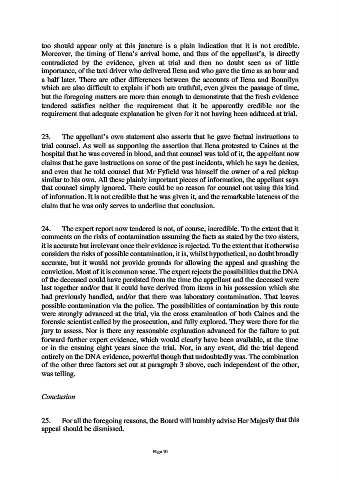Page 489 - Magistrates Conference 2019
P. 489
too should appear only at this juncture is a plain indication that it is not credible.
Moreover, the timing of Ilena’s arrival home, and thus of the appellant’s, is directly
contradicted by the evidence, given at trial and then no doubt seen as of little
importance, of the taxi driver who delivered Ilena and who gave the time as an hour and
a half later. There are other differences between the accounts of Ilena and Bonnilyn
which are also difficult to explain if both are truthful, even given the passage of time,
but the foregoing matters are more than enough to demonstrate that the fresh evidence
tendered satisfies neither the requirement that it be apparently credible nor the
requirement that adequate explanation be given for it not having been adduced at trial.
23. The appellant’s own statement also asserts that he gave factual instructions to
trial counsel. As well as supporting the assertion that Ilena protested to Caines at the
hospital that he was covered in blood, and that counsel was told of it, the appellant now
claims that he gave instructions on some of the past incidents, which he says he denies,
and even that he told counsel that Mr Fyfield was himself the owner of a red pickup
similar to his own. All these plainly important pieces of information, the appellant says
that counsel simply ignored. There could be no reason for counsel not using this kind
of information. It is not credible that he was given it, and the remarkable lateness of the
claim that he was only serves to underline that conclusion.
24. The expert report now tendered is not, of course, incredible. To the extent that it
comments on the risks of contamination assuming the facts as stated by the two sisters,
it is accurate but irrelevant once their evidence is rejected. To the extent that it otherwise
considers the risks of possible contamination, it is, whilst hypothetical, no doubt broadly
accurate, but it would not provide grounds for allowing the appeal and quashing the
conviction. Most of it is common sense. The expert rejects the possibilities that the DNA
of the deceased could have persisted from the time the appellant and the deceased were
last together and/or that it could have derived from items in his possession which she
had previously handled, and/or that there was laboratory contamination. That leaves
possible contamination via the police. The possibilities of contamination by this route
were strongly advanced at the trial, via the cross examination of both Caines and the
forensic scientist called by the prosecution, and fully explored. They were there for the
jury to assess. Nor is there any reasonable explanation advanced for the failure to put
forward further expert evidence, which would clearly have been available, at the time
or in the ensuing eight years since the trial. Nor, in any event, did the trial depend
entirely on the DNA evidence, powerful though that undoubtedly was. The combination
of the other three factors set out at paragraph 3 above, each independent of the other,
was telling.
Conclusion
25. For all the foregoing reasons, the Board will humbly advise Her Majesty that this
appeal should be dismissed.
Page 10

